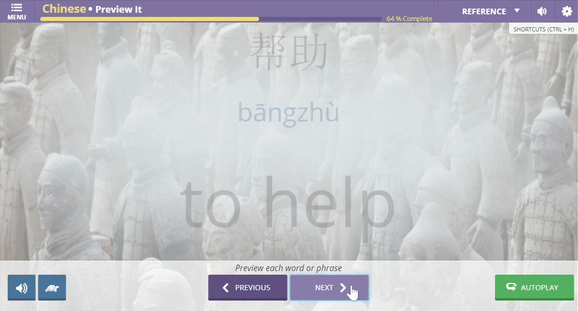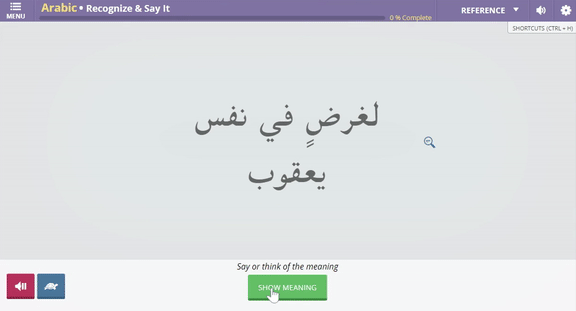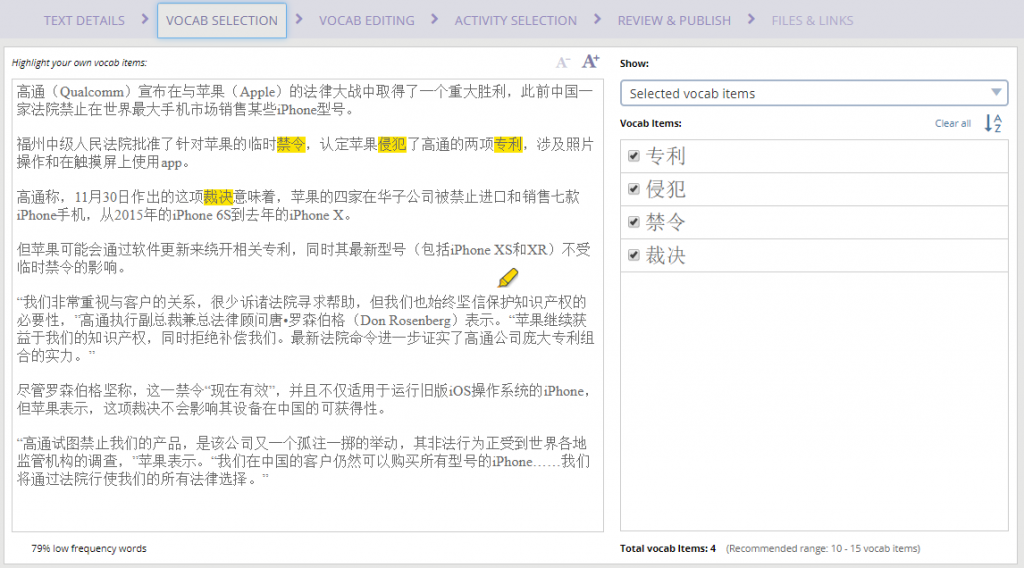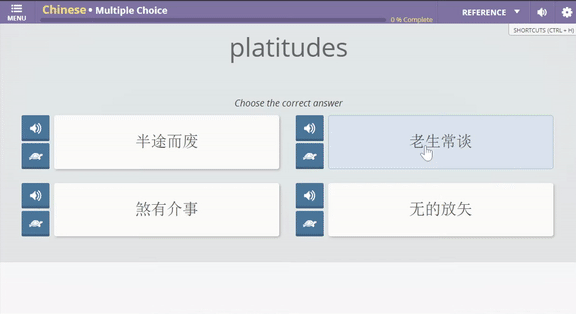Why focus on vocabulary? Posted by Transparent Language on May 20, 2019 in For Learners, Learning + Usage Tips
“Why do you focus so much on vocabulary in your language platforms?”
We get that question a lot, and it’s a more interesting question than you might think. We focus on language proficiency, which is largely made up of two things: vocabulary (declarative knowledge) and skills like pronunciation, grammar, structure, automaticity (procedural knowledge).[1]
The CL-150 Platform and Transparent Language Online are specifically designed to drive the accelerated acquisition of language proficiency. It turns out that more efficiently driving timely, relevant vocabulary learning has a bigger impact on that than one might think.
Let’s unpack this one piece at a time, starting with the original question about vocabulary.
Why do we emphasize vocabulary?
First, proficiency levels have consistently been shown to increase in tandem with vocabulary size.[2][3][4] In fact, studies have shown that, of all factors contributing to language proficiency, vocabulary size is by far the single most significant factor.[5][6][7]
A larger vocabulary equates to more than being able to come up with or understand a particular word or phrase:
- Lexical knowledge enables learners to use the language[8] and underpins communicative competence.[9]
- Second language readers rely significantly on known vocabulary, and that vocabulary contributes to understanding context,[10] which is a major factor in both reading and listening comprehension.
- A sufficiently large and carefully curated vocabulary supports learning grammar rules[11] and becomes the foundation on which grammar rules can be applied in new and imaginative ways[12].
As you can see, it’s not a question of vocabulary vs. grammar. When it comes to moving the proficiency needle, we believe technology is best poised to drive mastery of the relevant vocabulary, which in turn better enables grammar learning and application in a classroom or in other contexts.
A favorite quote of ours comes from linguist David Arthur Wilkins: “Without grammar very little can be conveyed, without vocabulary nothing can be conveyed.” But perhaps counter-intuitively, doing vocabulary better doesn’t mean de-emphasizing grammar, pronunciation and other skills. To the contrary, it smooths the entire process of acquiring vocabulary and skills together, resulting in more of everything in any fixed amount of time.
How do we deliver the right vocabulary, at the right time?
A strong vocabulary is made stronger by teaching the most useful words and phrases.
At lower proficiency levels, “most useful” typically means covering high-frequency words. Consider that in English, the 100 most frequent words make up about 50% of words used in a typical text; the 1,000 most frequent make up about 70%; and the 5,000 most frequent make up about 80%.[13] If a novice learner does not acquire and maintain a strong foundation of high-frequency terms, he or she will struggle to build proficiency and work with any kind of authentic materials.[14]
We also usually arrange our content in such a way that it expands on previously acquired lexical items. Our platforms support any methodology, and some instructors or administrators might deal with this question of “cognitive leveling” differently, but typically, in the case of longer phrases, for instance, we introduce smaller components, and then add onto them until the desired phrase or sentence is complete.

At higher proficiency levels, “most useful” can mean illustrating more complex forms of morphology or syntax, domain-specific terminology or simply more vocab depth, including idioms, collocations, etc. Vocabulary is intentionally chosen to reduce vocabulary gaps and help learners apply word knowledge for greater comprehension.[15]

For example, when hiring language experts to create Cohort lessons, we specifically search for linguists or teachers with experience in passage rating, who can skillfully choose level-appropriate vocabulary that helps learners comprehend and discuss the lesson text. This vocab could include specialized, low-frequency terms that fill in vocabulary gaps, or words and phrases that illustrate more complex grammar structures. 
How do we support vocab acquisition and sustainment?
Let’s circle back to the idea of supporting vocab acquisition with technology. We believe in letting technology and human instructors do what they each do best. Thanks to features like automated scoring, spaced repetition algorithms customizing tasks to the strengths and weaknesses of each individual user, technology is uniquely suited to quickly drive mastery of declarative content like vocabulary.
Repeated Exposure and Contextual Learning Activities
Many language learning apps and programs feature flashcard style activities that drill vocabulary. While we do include flashcard activities, the key to vocabulary instruction is repeated exposure, particularly seeing the word in different contexts.[16] Our suite of nearly three dozen learning activities includes all four modalities (listening, speaking, reading, and typing) as well as contextual, comprehension activities.

All vocabulary activities are supported by a spaced repetition algorithm that automatically differentiates that learning. Practice is more effective when spread out over time, and spaced practice is shown to enhance memory and transfer that learning to new contexts.[17]

Reviewing and Maintaining with Learned Vocab Refresh
Of course, vocabulary is only useful if you remember it when you need it.
The working memory has a limited capacity and is constantly threatened with decay.[18] The more encounters with declarative material—the more you review your vocabulary at the right time—the less decay occurs.
 The Learned Vocab Refresh system in the CL-150 and Transparent Language Online removes the burden of tracking what you know and when you need to review it. Learned Vocab remembers which words and phrases you’ve studied, keeps track of their status (fresh, stale, or archived), and creates opportunities for you to re-engage with words or phrases that are going stale. Learners can even subscribe to the Daily Refresher for a daily reminder of what needs refreshing.
The Learned Vocab Refresh system in the CL-150 and Transparent Language Online removes the burden of tracking what you know and when you need to review it. Learned Vocab remembers which words and phrases you’ve studied, keeps track of their status (fresh, stale, or archived), and creates opportunities for you to re-engage with words or phrases that are going stale. Learners can even subscribe to the Daily Refresher for a daily reminder of what needs refreshing.
And because not all learning happens inside our learning platforms, learners can add their own custom Learned Vocab—and we’ll keep track of it and help you review it all the same!
That’s quite a long answer to the “why vocabulary” question, but it’s actually just the beginning. A larger vocabulary is directly related to higher proficiency, and tech makes it newly possible to more quickly acquire and maintain that large vocabulary.
Interested in seeing how our tech drives declarative during on-the-job language sustainment and enhancement? Complete a sample CL-150 Cohort lesson in Spanish, Russian, or English.
Works Cited
[1] Ullman, Michael T. (2016) The Declarative/Procedural Model: A Neurobiological Model of Language Learning, Knowledge, and Use
[2] Huhta, Ari J. et al. (2011) Diagnosing reading in L2 – predictors and vocabulary profiles, Vortrag auf der ACTFL CEFR Conference 2011, 4.-6. August 2011, Provo, Utah (USA).
[3] Milton, J., & Alexiou, T. (2010). Developing a vocabulary size test for Greek as a foreign language
[4] Tschirner, E., J. Hacking, and F. Rubio. (2017). Relating Vocabulary Size to ACTFL Reading Proficiency Levels. Conference Paper, Refereed. ACTFL Annual Convention. Nashville, TN., 2017
[5] Alderson, J.C. (2005). Diagnosing foreign language proficiency. London: Continuum.
[6] Laufer, B. (1992). How much lexis is necessary for reading comprehension? In H. Bejoint & P. Arnaud (Eds.), Vocabulary and applied linguistics (pp. 126–132). London: Macmillan.
[7] Stæhr, L. S. (2008). Vocabulary size and the skills of listening, reading and writing. Language Learning Journal, 36(2), 139-152.
[8] Nation, I. S. P. (2001). Learning vocabulary in another language.
[9] Schmitt, N. (2000). Vocabulary in language teaching. Cambridge: Cambridge University Press
[10] Nagy, William (1995) On the Role of Context in First and Second Language Vocab Learning, 12-16.
[11] Nation, I.S.P. (2001) Learning Vocabulary in Another Language, 336.
[12] Lewis, M. (2002) Implementing the Lexical Approach: Putting Theory into Practice.
[13] Hiebert, Elfrieda H. (2005) Teaching and Learning Vocabulary: Bringing Research to Practice.
[14] Graves, Michael F. (2012) Teaching Vocabulary to English Language Learners, 10-34.
[15] Butler et al. (2010) Research Synthesis: A Review of the Current Research on Vocabulary Instruction.
[16] Nagy, William (1995)
[17] Kang, Sean HK. (2016) Spaced Repetition Promotes Efficient and Effective Learning: Policy Implications for Instruction.
[18] Cowan. (2014) Working Memory Underpins Cognitive Development, Learning, and Education.

Build vocabulary, practice pronunciation, and more with Transparent Language Online. Available anytime, anywhere, on any device.




Leave a comment: